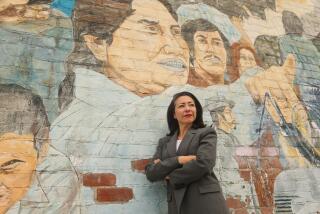Tide of Radicalism Ebbs in Santa Monica as Council’s Factions Mellow
- Share via
Cities have a way of attracting nicknames that stick. Philadelphia is the City of Brotherly Love. New Orleans is the Big Easy. New York is the Big Apple. And Santa Monica is the People’s Republic. Or is it?
Anyone who has spent much time around Santa Monica City Hall recently may have noticed a distinct shift in the political winds. The city that gained a reputation for radicalism nearly a decade ago for its rigid rent-control law and its monumental political battles has become a fairly conventional place.
The acrimony that had enveloped Santa Monica like a thick fog is gone. So are the clear lines of demarcation between the city’s rival political factions--the liberal Santa Monicans for Renters’ Rights and the moderate All Santa Monica Coalition. Members of the two groups rarely stray into controversial territory these days and frequently cross factional lines on major issues.
Nothing Wild and Woolly
The city still travels down some progressive paths when it comes to housing and economic development. But most people agree that the wild and woolly days that gave rise to the city’s reputation as a left-wing political haven are over.
“I guess we have all been on the council long enough to understand what the job is, and we are all dedicated to doing it well,” said Mayor James P. Conn. “There’s an effort on our part to add humor and avoid bitterness.”
Many people credit Conn with helping to break down the old barriers between the two factions. The mayor recently split with his two allies from Santa Monicans for Renters’ Rights on the City Council and joined the All Santa Monica Coalition in supporting a hotly contested development agreement for Colorado Place.
The action clearly piqued those who opposed the project. But it also showed that members of the two organizations can come together on important issues. Alan Katz, the only independent on the seven-member council, said his colleagues have realized that compromise is more productive than combat.
“I think that there is a sincere desire to work together as one City Council,” Katz said. “I’m not saying that we have a lot of lifetime friendships forming here. . . . But there is a collegial attitude.”
Gradual Harmony
William H. Jennings is the only council member who has belonged to both groups. He said that the two factions have gradually drawn closer to one another and abandoned the view that they have to be at odds to be effective.
The voters also played a part in changing the council’s posture. The two factions came out of last year’s election with an equal number of seats for the first time. Conn, Dennis Zane and David Finkel represent Santa Monicans for Renters’ Rights. Jennings, Herb Katz and Christine E. Reed are the coalition’s representatives.
The lack of a majority has forced each group to do more consensus-building. But it has also robbed them of their identity and sense of purpose, many observers say. Santa Monicans for Renters’ Rights has held only one major press conference this year. The All Santa Monica Coalition has held none.
In their places have emerged fringe groups that are critical of both camps. To the right are the landlords and conservative businessmen who say the All Santa Monica Coalition has abandoned them in favor of the city’s renters.
Nonexistent Coalition?
“There has been some mellowing,” said Stan Robbins, a Santa Monica businessman. “The general consensus is that the coalition no longer exists.”
To the left are the members of the city’s emerging slow-growth movement who say that Santa Monicans for Renters’ Rights has dropped the ball on development.
“There is a great deal of dissatisfaction among the Santa Monicans for Renters’ Rights membership at their inability to take an active role in the major development issues that are facing the city,” said John W. Belsher, the president of Santa Monicans for Reasonable Growth. “What you are getting is an emergence of slow-growth advocates who are outside of SMRR.”
Zane, the point man on rent control and other issues for Santa Monicans for Renters’ Rights, disagreed. The councilman said that the tenant group remains dedicated to its liberal social and political agenda.
Zane noted that Santa Monicans for Renters’ Rights engineered a recent council move opposing the nomination of Robert H. Bork to the U.S. Supreme Court. Zane, Conn and Finkel also were arrested recently while protesting at the Nevada nuclear test site. The group has voted in favor of providing a high level of social services for the homeless who have become so visible in Santa Monica.
The major difference now, Zane said, is that their political foes have accepted their ideas and joined forces on SMRR-initiated projects such as the restoration of the Santa Monica Pier, the revitalization of the Third Street Mall, the development of Santa Monica Airport and the land-use plan.
“The coalition has gravitated toward the SMRR agenda,” Zane said. “People have been forced to gravitate toward it or wither. . . . If SMRR has lost its identity, it’s because the coalition has basically co-opted it.”
Councilwoman Reed, the coalition’s symbolic leader, said Zane has it backwards. Reed said that the council members from Santa Monicans for Renters’ Rights have essentially been “mainstreamed” during their years in office.
“Santa Monicans for Renters’ Rights is not even the most liberal group in Santa Monica anymore,” Reed said. “I don’t know if SMRR is more moderate, but they have certainly become more practical.”
Mark E. Kann, a USC political science professor, wrote a book on Santa Monica politics last year called “Middle Class Radicalism in Santa Monica.” In the book, Kann argued that Santa Monicans for Renters’ Rights never had much of a social/political agenda beyond rent control to begin with.
‘People Got Exhausted’
It was his view then and now that the liberal movement has run out of steam.
Santa Monica, a city with a desirable seaside ambiance and 90,000 residents, was still seen as a sleepy beach town, a place that had once cast the majority of its 1964 presidential votes for conservative Republican Barry Goldwater, when the first stirrings of the tenant movement were felt in the late 1970s.
The movement was born out of frustration with rampant development and skyrocketing housing costs and drew together a peculiar coalition of senior citizens who feared evictions and young activists who were affiliated with the Economic Democracy campaign of Assemblyman Tom Hayden (D-Santa Monica).
In a city where 80% of the residents are tenants, members of the group succeeded in passing one of the nation’s toughest rent-control laws in 1979, and in 1981 they completed their coup by capturing a majority of City Council seats.
Stunned at Moratorium
The business community, already shaken by the rigid rent-control law that prohibited landlords from raising rents when tenants left their apartments, was flabbergasted when the new council enacted a building moratorium.
In those days, City Council meetings often raged on past 2 a.m. as council members debated such weighty domestic and international issues as proposed cuts in Social Security, U. S. intervention in El Salvador, Soviet intervention in Poland and Israel’s right to defend its borders against Lebanon.
The Los Angeles Times ran a story with a headline that stated “Santa Monica Has Its Own Foreign Policy” and emotions ran so high that Santa Monica City Atty. Robert M. Myers, the author of the city’s rent-control law, and others had to be escorted out of City Hall by armed police on one occasion.
“Welcome to the People’s Republic of Santa Monica,” apartment owner K.B. Huff told 100 demonstrators gathered outside of City Hall during that period. “You’re facing the Kremlin. We don’t have a City Hall. We have a Kremlin.”
Symbolic Leader
The symbolic leader of Santa Monicans for Renters’ Rights and the object of much of the angry rhetoric was Ruth Yannatta Goldway, an attractive, charismatic and somewhat caustic woman who became mayor when the group gained control of the council.
Goldway was touted by her allies as a leader for her times, a person who understood people’s property rights. But her times were short-lived. In a stunning upset in 1983, the All Santa Monica Coalition, which had formed in opposition to Santa Monicans for Renters’ Rights, drove Goldway from office.
Ken Edwards took over as mayor and continued to promote the Santa Monicans for Renters’ Rights agenda. But a steady erosion of the group’s power continued.
The tenant group lost the council majority to the coalition in 1984. And the group failed in an ambitious effort to regain control in November, when each faction emerged with three Council seats.
In the interim the two political groups learned the art of compromise. They voted unanimously or in factional splits more often than they opposed one another in the year before the 1986 election.
Quiet Agreement
In November, the coalition broke precedent by approving Conn as mayor. And several months ago the two organizations quietly agreed on a way to support neighborhood groups, an issue that had bitterly divided them for years.
Santa Monica Bank Chairman Austin said the rest of the world is slowly realizing that Santa Monica is in retreat from radicalism. The banker who once complained of feeling like a “bastard” in his own city noted that Conn met with him when he became mayor and extended a hand of friendship.
Others, however, say that repairing Santa Monica’s reputation among businessmen may take longer. James W. Baker, a spokesman for apartment owners, said Santa Monica will retain its radical reputation as long as the rent-control law remains in effect.
“The city, underneath its placid facade, is still seething with resentment and frustration,” Baker said. “And it is capable of erupting at any moment.”
Until then, Santa Monica probably will continue to play down its left-wing image as it quietly confronts the same kinds of problems that face other California cities: growth, revenues, schools and the environment. Councilman Katz said the rivalry between the competing factions in Santa Monica is now largely symbolic, something trotted out during elections.
“Over time the entrenched factions become archaic,” Katz said. “They exist only to perpetuate themselves. To the extent that differences exist, they exist between individuals as opposed to two warring political factions.”
More to Read
Sign up for Essential California
The most important California stories and recommendations in your inbox every morning.
You may occasionally receive promotional content from the Los Angeles Times.












